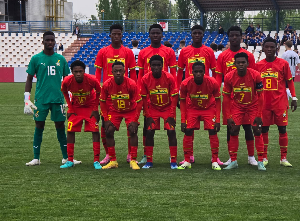- Home - News
- TWI News | TV
- Polls
- Year In Review
- News Archive
- Crime & Punishment
- Politics
- Regional
- Editorial
- Health
- Ghanaians Abroad
- Tabloid
- Africa
- Religion
- Election 2020
- Coronavirus
- News Videos | TV
- Photo Archives
- News Headlines
- Press Release
Business News of Wednesday, 12 April 2000
Source: Reuters
Ashanti reports loss after tumultuous year
By Ben Hirschler
LONDON, April 12 (Reuters) - Ghanaian mining company Ashanti Goldfields Co Ltd reported a loss for 1999 after exceptional charges on Wednesday following a tumultuous year in which it came close to collapse due to huge derivative losses.
Africa's third biggest gold producer sank to a loss of $183.9 million in 1999 from a profit of $40.7 million. Earnings before exceptionals were $66.1 million from $73.9 million, mainly due to lower realised gold prices over the year.
The exceptional charges of $250 million included a $171.1 million write-down of fixed assets at the Obuasi mine, where surface mining is to end. The company is paying no dividend.
Ashanti was caught out by a spike up in gold prices last autumn which flipped its gold hedging book from a positive $290 million at mid-year to a loss of $570 million in early October.
Its problems were compounded when a proposed merger with 32 percent shareholder Lonmin Plc (quote from Yahoo! UK & Ireland: LMI.L) was blocked by the Ghana government, which holds 20 percent and a veto vote in the country's biggest company.
Since then Ashanti has revamped the board, secured a refinancing deal with its banks and last week sold a 50 percent stake in the promising Geita gold mine in Tanzania to AngloGold in a deal which will bring in $335 million of cash.
``Hopefully, the decks have now been swept clear and we can start to look at the company's potential going forward,'' said Charles Kernot, mining analyst at BNP Paribas.
``AngloGold is a good deal. We'll have to see how close the relationship between Anglo and Ashanti becomes -- together they would create a very serious force for gold mining across the African continent,'' he added.
LONG HAUL TO RESTORE CONFIDENCE
Chief Executive Sam Jonah acknowledged it would be a long haul to restore investor confidence in the group, which has seen its shares collapse to just $2-1/4 from the $20 at which they were floated in 1994.
``We recognise... that the task of rebuilding management credibility and shareholder value will be difficult, painstaking and long,'' he said.
The group's hedge book showed a mark-to-market loss of $146 million at the end of March, down from $231 million three months earlier, based on a gold price of $275 per ounce against $290.
Mark Arnesen, the new managing director of international treasury, said the company was now starting to restructure the book and he expected Ashanti's banks to approve its new hedge policy by the end of the week.
Ashanti has secured three years of margin-free trading from counterparties and Arnesen said the firm would use this period to step up the hedge restructuring programme, including reducing commitments and gold lease rate exposure.
GHANA PRODUCTION DECLINING
Ashanti previously reported in January that 1999 gold production hit a record 1.56 million ounces from 1.54 million a year earlier. The final figure for cash operating costs in 1999 was $205 an ounce -- marginally down on the initial unaudited $206 -- against $218 in 1998.
The company said ``conservative'' projections showed output dipping to around 1.3 million ounces by 2004 with lower production from the mature Ghana mines offsetting the contribution from its 50 percent share in Geita, which is expected to be commissioned this June.
However, output could be maintained at around 1.6 million ounces if Ashanti and AngloGold agree to expand Geita from its current 500,000 ounces a year production target.










